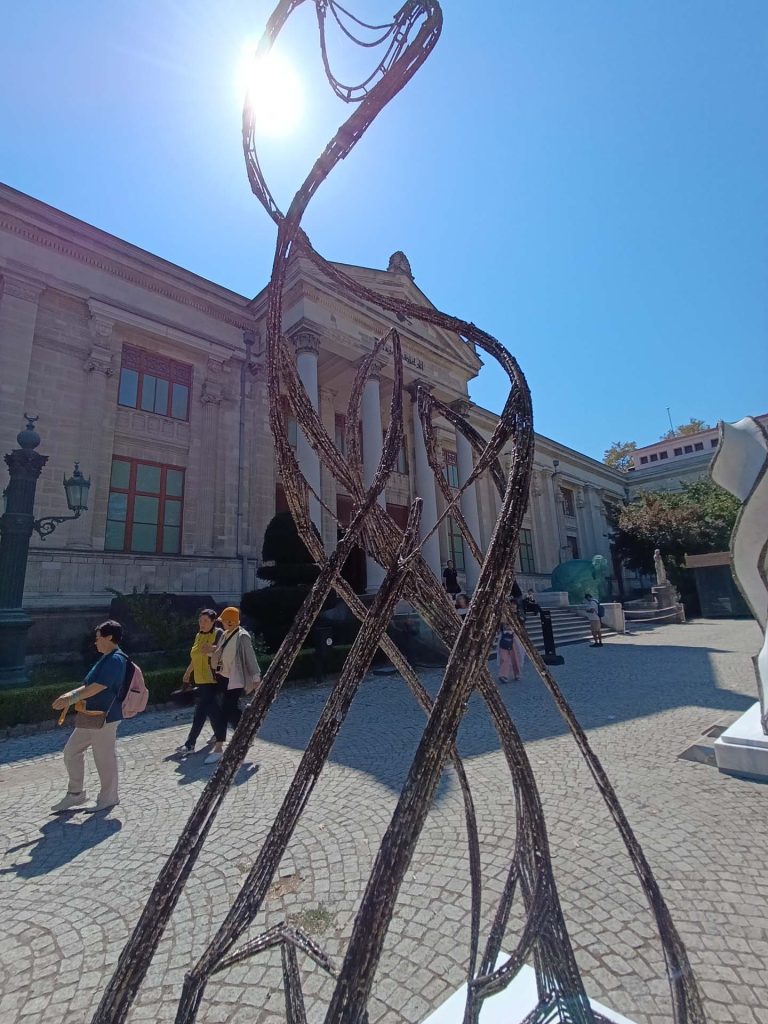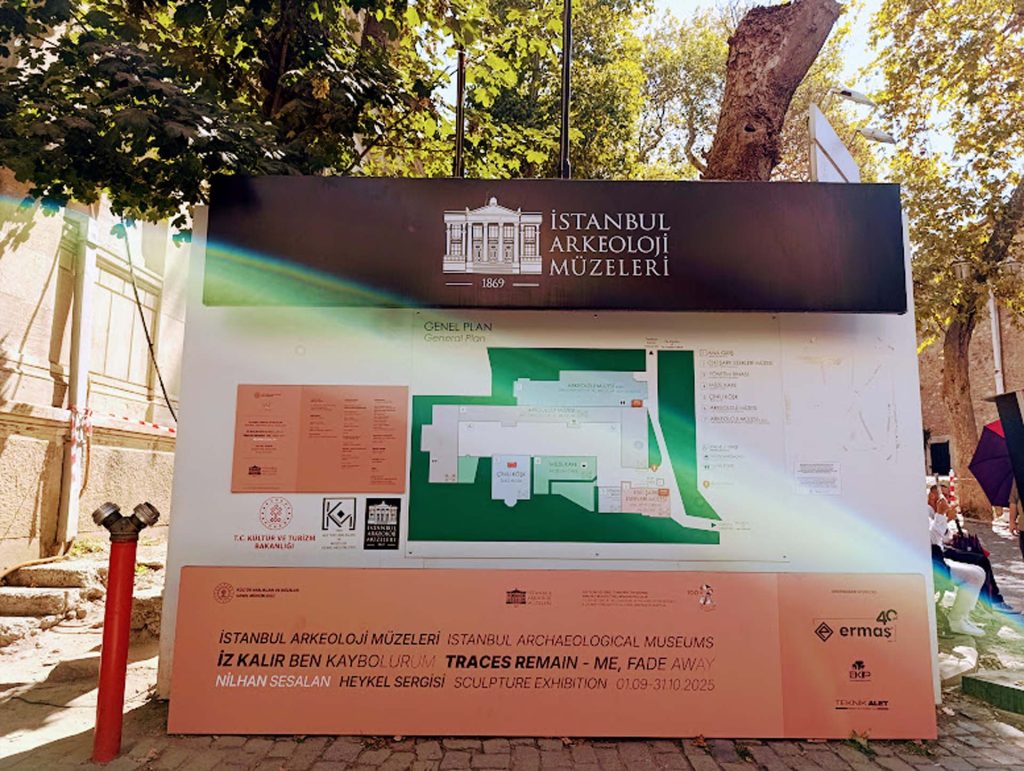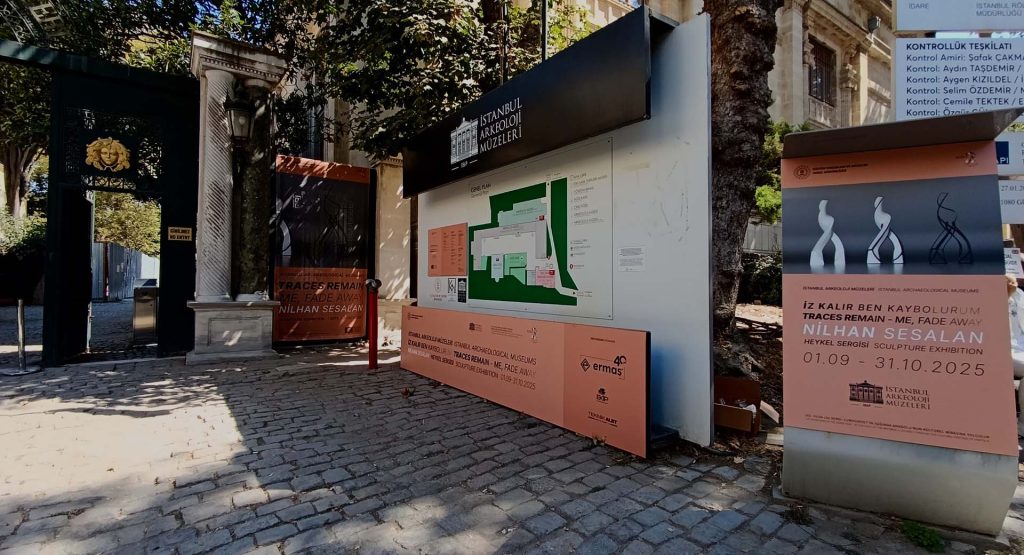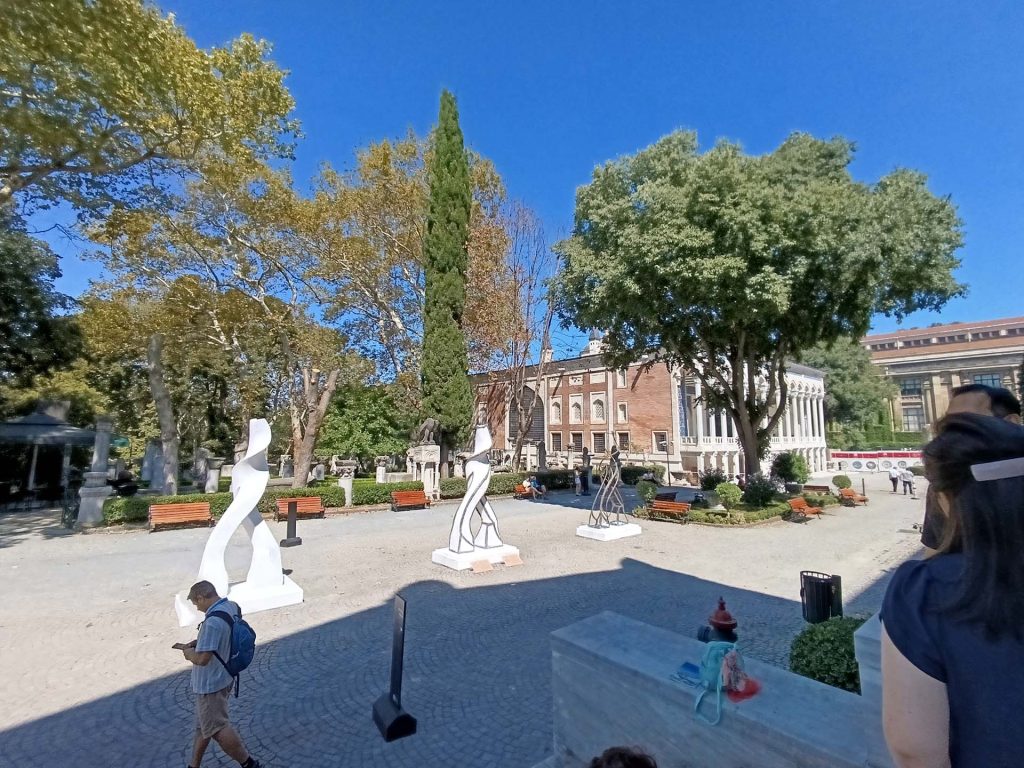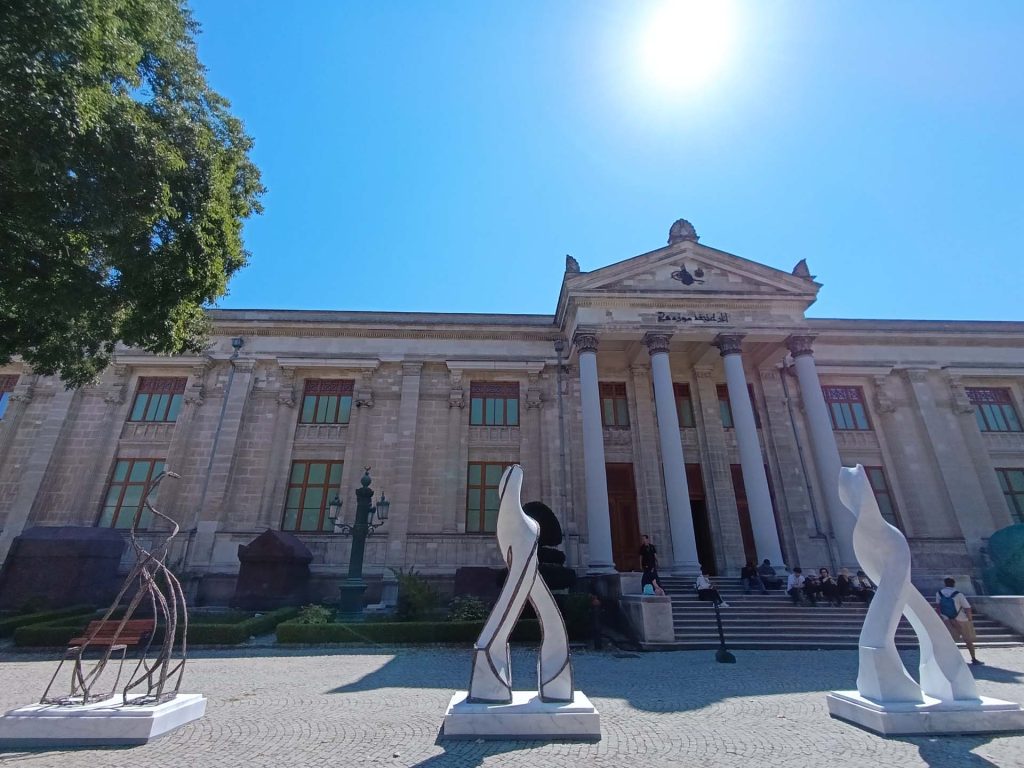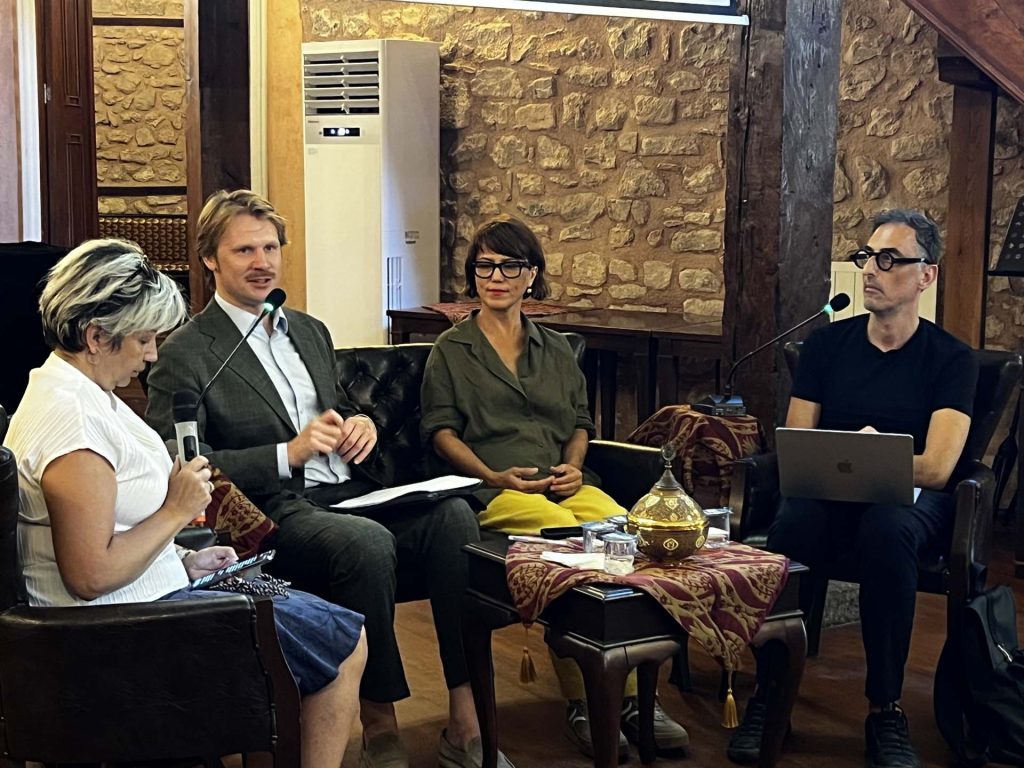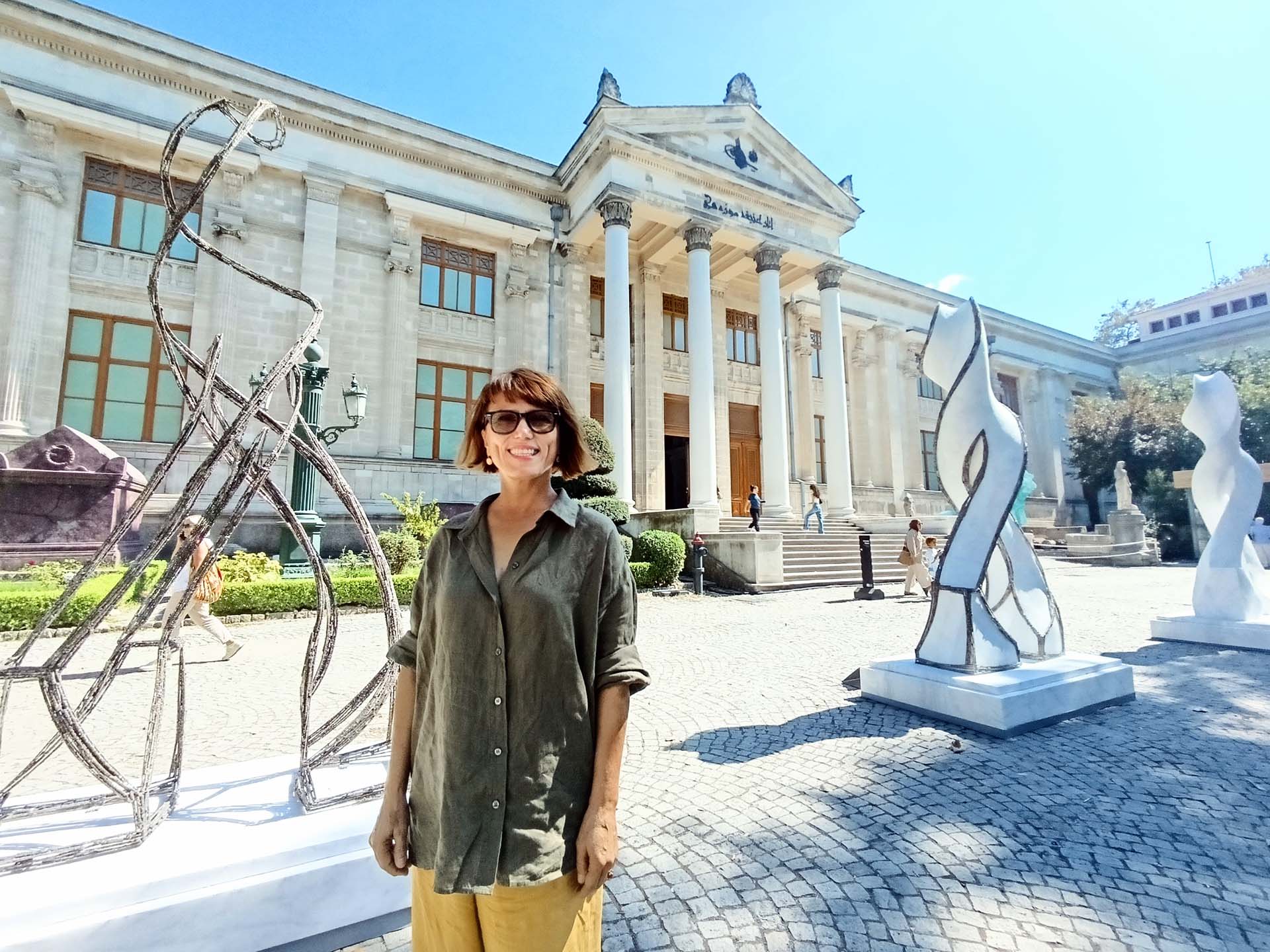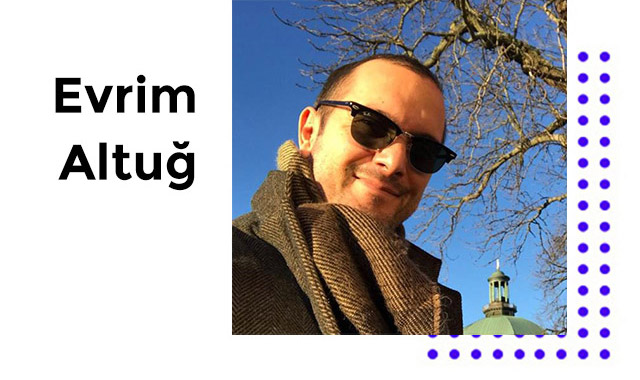
Nilhan Sesalan’s three-part installation “Traces Remain, me, fade away”, placed in the garden of the Istanbul Archeology Museums (IAM) – signed by Osman Hamdi Bey, founder of the Academic (MSGSU) – as a part of the Ministry of Culture and Tourism of the Republic of Türkiye’s “100+2 Temporary Museum Exhibitions Project,” can be viewed until October 31.
According to experts, “Sesalan’s works do not propose a singular reading of national memory; instead, they stage its fragility through various possible interpretations. The artist’s contribution is clearly her own.” The artist also “draws on Türkiye’s geography, memory, and cultural hybridity. She is not only a sculptor within the international tradition; she is a sculptor of Istanbul, a sculptor of Anatolia, a sculptor of multiple, layered histories.” Sculptor Sesalan shared her project with Arkas News.
Within the framework of the Ministry of Culture and Tourism of the Republic of Türkiye’s “100+2 Temporary Museum Exhibitions Project,” dedicated to the 102nd anniversary of the Republic, sculptor Nilhan Sesalan’s new work “Traces Remain,me, fade away” has been presented to art lovers. The exhibition can be visited between September 1 and October 31 in the garden of the Istanbul Archaeology Museums (IAM), where Sesalan, at just 17 years old, once grew up sketching among its grounds.
It is best to state from the outset: The exhibition, in a sense, stands as an art-historical “restoration of memory” directed at the founding of the Academy of Fine Arts (today’s Mimar Sinan Fine Arts University – MSGSU), established in 1882 as the Sanâyi-i Nefîse-i Mekteb-i Sâhâne, the first art academy of our country. Through Sesalan’s lens, it promises a feminine self-portrait experience that bridges yesterday, today, and tomorrow.
Furthermore, with MSGSU-trained Art Historian Hasan Karakaya serving as Art Consultant, this exhibition—managing to be both powerful and modest at once—resides in the museum’s garden, overlooking Gulhane Park. In the collective, tranquil “sculpture garden” among centuries-old trees and sarcophagi, it leaves us witnessing a “live dialogue.”
With the emphasis of Professor Karakaya’s collaboration with Sesalan, the exhibition “…through interdisciplinary methods, seeks to reach the pure state of the artwork, addressing the boundaries inherent to it as ‘the disappearing self and remaining traces.’ The ‘disappearing self’ symbolizes the present and the near future, while its futurist aspect underscores how memory, orientation, movement, and music will continue to carry the museum’s connections from past to future.”
The three works in the exhibition, each three meters high and created from stone carving, stainless steel, and welded materials, establish connections between past / present / future and trace / existence / meaning. Much like how clay, stone, and copper in nature transform into material with essence and form, the sculptures draw from both the thought and the process that they embody.
As is well known, established under the Imperial Museum, the IAM hosts rare works from Classical, Roman, and Anatolian sculpture schools dating from Antiquity, along with numerous unique statues from various civilizations across the Ottoman geography.
Sesalan is both a graduate and a lecturer of the MSGSU Sculpture Department, whose history reaches back to the Sanâyi-i Nefîse Mektebi. She was also a student of contemporary Turkish sculptor Ali Teoman Germaner (Alos). She completed her master’s degree at the same institution and department with a thesis on prehistoric sculptures, the earliest phase of human history. In this same historical atmosphere, the sculptor is presenting her three new works, dated 2025, to visitors for the first time.
Indeed, the first international gathering held on September 3, Wednesday, at the Ahmet Hamdi Tanpinar Literature Museum Library in Istanbul’s Gulhane, also recorded the global interest in Sesalan’s work. (On the subject of the Academy, it is worth noting that the Tanpinar Literature Research and Application Center, founded on December 12, 2017, under the leadership of MSGSU Rector Prof. Dr. Handan İnci, also continues its activities at this address.)
Likewise, at the historical venue where Academy professor and sculptor Zuhtu Muridoglu opened the first sculpture exhibition in our country, art historians and curators Marek Dominik Wolynski, Yazid Anani, and Sesalan, with the support of translator Gulay Goncu, met with art lovers in Gulhane.
At the meeting attended by IAM Director Rahmi Asal and Library Supervisor Tuncay Dogan, Anani, in his presentation referencing global thinkers such as Frantz K. Fanon, Homi K. Bhabha, and Slavoj Žižek, described the project “Traces Remain, me, fade away” as follows:
“Sesalan’s sculptural installation in the garden shows that, compared to the imagined form, material is always secondary. Her work is not about ensuring continuity with the museum’s archive of Anatolian artifacts, but about re-recording it, setting fragments of memory and history into motion, and revealing the ruptures that define modernity itself. The solidity of stone or metal is reshaped to express absence and disappearance, subjugating the material in order to give form to the temporary.”
Anani also decoded the art-historical codes of the relationship between Sesalan and her teacher Alos with the following interpretation:
“Much like other nations in the region, the Modern Türkiye project, while not entirely colonial, often immobilized tradition; it codified folk culture, rebranded Anatolian motifs as national heritage, and presented them as timeless anchors of identity.
Within this framework, both Alos and Sesalan opposed such immobilizations. Alos transformed myth into allegory, releasing it from nationalist closure and reworking it into abstraction.
Sesalan, on the other hand, reanimated memory, refusing to let it remain in the archive, introducing ruptures to the assumed continuity of history, and pulling it into a lyrical sculptural form.”
On the other hand, as he concluded his speech, Yazid Anani earned full applause by adding these expressions to artist Sesalan’s project:
“Sesalan’s works do not propose a singular reading of national memory; instead, they stage its fragility through various possible interpretations. The dialogue she establishes with stone and metal does not testify to an uninterrupted continuity but speaks of what has disappeared. Rather than permanence, what remains is a trace, a sign of absence. While invented traditions attempt to conceal rupture, her works insist on rupture as a condition. In her practice, what endures is not certainty but an awareness of disappearance.
So then: What does it mean for this installation to take place here, now? What does it suggest about how we understand the role of museums, about how we might imagine continuity and rupture in nationalism in the future?
If Sesalan’s art reminds us of tradition’s fragility and modernity’s instability, then her presence here calls on us to rethink whether the museum itself can be redefined: not as a place that secures identity or stores origins, but as a space of renewal, where gestures, rhythms, and stories are brought back to life amidst disorder and political turbulence.
What matters is precisely this dynamic between Sesalan’s exhibition and the Museum; here, the institution is not only a site where works or rituals are preserved in their original form, but also a place where, when placed side by side with art and drawn into the urgency of today, they are re-signified.”
With the support of institutions such as Ermas, Teknik Alet, and Ekip, the exhibition “Traces Remain, me, fade away” also hosted Marek Wolinsky, who began his allotted time at the meeting with the words, “Istanbul is already a living sculpture.”
Speaking of the exhibition in this ‘timeless’ city—one he considers a kind of tablet, parchment, or palimpsest produced by stone, memory, and time—Wolinsky drew particular attention with his remarks on Sesalan’s art, which he integrated under different themes:
“Her sculptures are not elaborate narratives carved into stone; they are poems distilled into form. They are gestures akin to ‘haikus,’ holding entire worlds within them. In this sense, she is in dialogue with (Constantin) Brâncusi, who sought the essence of things; with (Isamu) Noguchi, who allowed sculpture to become a cultural bridge; and with (Anish) Kapoor, who transformed matter into a threshold toward the immaterial.
At the same time, Nilhan’s contribution is unmistakably her own. She draws upon Türkiye’s geography, memory, and cultural hybridity. She is not only a sculptor of the international tradition; she is a sculptor of Istanbul, a sculptor of Anatolia, a sculptor of multiple, layered histories.
Stone lies at the heart of her practice. In quarries she searches for it, touches it, feels it, listens to it—as though every piece of marble or granite were not merely a source but a collaborator. Stone is also time itself. It is a place that bears witness to geological ages, civilizations, and transformations.”
Having also worked with artist Sesalan during an international workshop and exhibition in Riyadh in 2019, Wolinsky read her exhibition at IAM to the participants as follows:
“So, how can we read Nilhan’s exhibition in the context of IAM? I propose reading it in three acts:
Act One: The emergence of form. A soft, white presence scattered by the wind; a stone body that feels weightless. We register its curves, its thinned passages, its promise of almost letting the light pass through. We are invited to walk around it to sense how the stone conveys light and shadow like music.
Act Two: The mapping of emptiness. A sibling form outlined in black ink. Here the line operates like an instrument of memory. It recalls maps, borders, ornaments, and shadows—without ever becoming any of them. The line is the sculpture’s way of keeping its promise to light.
Act Three: The trace. The white interior recedes. All that remains is the line. Presence becomes a speaking absence. The trace is not a lack; it is a figure in its own right, a way of saying that what fades does not vanish, becoming instead an instrument of memory.
Together, these three acts rehearse all of Nilhan’s work: from leaf to tree, seed to egg, stone to light, border to fading line.
They create a space into which each of us can bring our own memories: the geographies and pasts we come from, the languages we carry, the homes we long for, the futures we dare to map.
So how should we approach the works in this exhibition?
I would advise you to avoid being spectators who seek explanations. Also, stay away from being critics who seek classifications.
I would suggest being companions willing to walk through the landscapes of memory and material that Nilhan creates.
Because in Nilhan’s hands, stone breathes. Negative space speaks. Abstraction remembers. And in today’s world, which often rushes to shout, define, and fix meaning, her works remind us of another possibility: that art can be a space for listening, for thinking, for poetic encounter.
Today, as we stand in this city of stone and light, let us allow her sculptures to guide us. And may they lead us not necessarily to answers, but perhaps to more questions. Not to conclusions, but to echoes. Not to a single map, but to maps that fade and return like tides, like seasons, like the city itself—still breathing and inspiring.
In this context, our exclusive interview with Nilhan Sesalan for Arkas News adds a personal dimension to the views of these two experts. Emphasizing that she has been in correspondence with the Ministry and the Museum for four years regarding this project, Sesalan does not hide her joy that it has finally been approved.
The artist, who describes the museum as a therapeutic space for herself and who usually exhibits abroad, notes that these works developed out of her desire to also exhibit in Türkiye and her connection with IAM. “With a very profound feeling, I strove to be worthy of the museum and its history,” says Sesalan, as she sincerely answers our questions.
How would you explain the connections between your previous works and this new installation in your own career?
All of my works emerge from one another like a ‘Matryoshka’ doll. For example, when I presented my Master’s project on Anatolian Prehistory, there were fig leaves on the figures. Those leaves later transformed into trees, into ‘leaf-trees’; all of them, in one way or another, come out of each other differently, and though they resemble one another, we might say this resemblance is the evolution of a shared feeling over time.
This singular installation of three works immediately brings to mind the art-historical idea of a ‘triptych.’ How do you relate to that? Could you interpret your work in this respect, as a kind of self-portrait where three dimensions overlap?
For some time, I have been drawing the ‘map of emptiness’ with lines on sculptures I create using ink. Later, the ink in that map of emptiness would disperse into infinity. With these sculptures, I engaged with permanence in the mind. Because in sculpture, my most fundamental sensation is that of the immaterial becoming material. Here too, I referenced the ‘limit that remains in the mind’ within infinity, and I used stone as the material.
This time, instead of ink, I drew the map of the work with stainless steel. At the top, with its surface definition, the sculptures are quite existential. They deal with an existentiality that concerns all of us. They are about being born, living, and passing away. In one sense, they also carry hope. They deal with the idea that disappearance does not occur in the mind, that a trace remains there.
I made a complete figure out of stone. Then, I created its ‘twin’ using its traces. Then, both the stone and the twin departed, leaving behind only traces and contours.
It is quite clear that you are also addressing the question of how the roots of humanity today might be represented here, in the garden of an Archaeology Museum. Did you focus on this?
Of course. First, in a very simplified sculpture, the desire arose to meet the museum. It wasn’t simply “I want to hold an exhibition in a museum”; rather, I felt the relationship with the museum drop into my heart as a ‘seed’ within the sculpture itself. That is why they are not separate—they are parts of the same fabric.
So, in this sense, can we say that the works are confronted with the problem of engaging both the pedestal and the trees in the garden, as well as the many columns, sarcophagi, and findings? If we focus on the trilogy, then, is there any urgency to this work? Why did you choose a trilogy?
That’s right. Always right. My concern is with meaning, and this has been true not only today but since I first came here at age 17. This place—which I call my ‘therapy space’—is where I was able to cope with many problems. I think the answer to your question goes back to why I came here at that age. Because it is something spontaneous. I would come here with all my troubles, test myself, and leave in a better state. Later, perhaps I can’t describe it much better than that—it must be such a place for me.
This is a work that remains on the threshold between the remnants in the garden and the memory inside the museum. Its state of in-betweenness is especially striking. People pass by it, touch it—girls, boys, babies, and elders… Of course, within the representational struggle of this sculpture, the issue of gender also arises. How do you bring together the struggle for existence with the art of sculpture? You mention existentialists, but when I look at this work, what comes to mind is not Camus or Sartre, but Beauvoir… What is your view?
I suppose I want to speak of this: perhaps, again, Hermaphroditus. Because for as long as I can remember, since I was born, I have defined myself as human. The division between woman and man struck me as odd even in childhood. I enjoyed my quality of being human. And I have never, still do not, separate myself as woman or man. This is reflected in my works.
How can the inside, outside, and influence of being an ‘individual’ be expressed and analyzed? It seems clear that you are truly concerned with this. In this sense, how do you observe people’s relationship with your works?
I think, first of all, it is a surprise for everyone here. When encountering abstract sculptures, what people were most curious about was how I managed to get permission! More than the production or economy of the sculptures, the whole process truly “scrubbed” me. But at the same time, it was a collective effort of friends. Hasan Karakaya was the Art Consultant, Ahmet Basar the Graphic Designer, Cengiz Yuzsever worked alongside me directly—he is my husband, we are a family of artists. My sister is also a sculptor. Ensar Tug prepared the project videos, and Cetin Korkmaz took the photographs. It was entirely a collective effort of friends, and that has been the strongest feeling for me right now. They surrounded me with their compassion at a time when I truly needed it, and they made me feel very good. Marek and Yazid as well—it was all collective!
Let’s say I have placed these works into life. If life accepts them, I will be very happy. What makes me feel warmest now is being surrounded by my friends!
In sculpture, one of the fundamental problems of artworks is that, for many reasons, they are often the first objects to be destroyed, treated as enemies. They become sources where anger takes form. All subjects give shape to their grievances here. Museums and collections are plundered, destroyed, stolen. While archaeology and contemporary art both work in this field, where do you place yourself within this tension—were you pushed or pulled?
During my conversations with the IAM staff—when the truck arrived for installation, amid the noise and dust—they too asked us questions. They wanted to know what we were doing. I told them, ‘Perhaps I am making one of the sculptures that the archaeologists once unearthed and placed here.’ Because at times, I feel as though I am always conversing with sculpture at a single point in time.
After all, isn’t sculpture the most essential form of a time machine? If you can witness and touch a trace left by someone long ago, you begin to interpret the same message with them. That is extraordinary.
Yes, in my master’s thesis on Anatolian Prehistory, I empathized with the prehistoric people. There was no writing; our only language of communication was matter. How did we experience matter, and with what feeling? Because we used the same clay, the same mud on this planet. I establish the same empathy here. While making these sculptures, I thought often of this: for example, the Mausoleum at Mugla, counted among the Seven Wonders of the World. I now most likely used one of the largest stones extracted from those great quarries again. The only difference between us was this: I used a stone older than them from the quarry, while they worked with stones older than me. Of course, that is if we are on a linear timeline. But if we are on a point-like timeline, then we were already in conversation together.
Speaking specifically about your works, where does this project intersect with the subject of sculpture’s ‘untouchability’? After all, in this triptych arrangement, by viewing the works from different angles and positions, they also transmit new visual and metaphysical messages generated from themselves. Each time, they redefine themselves for every viewer. As the cause of this multiple exposure within the trilogy, I also felt that in this work you captured something of the taste of British contemporary painter Francis Bacon’s triptychs, with their psychiatric intensity. Could this be described as a work focused on processes and cross-sections?
Like a silent dialogue, you’re right. Looking back at the past 35 years through these sculptures, I am glad that sometimes I experienced situations that embraced space, sometimes were as simple as a sculpture, and sometimes overlapped. It feels as if this ties them all together. It is like three different sensations of my life within process, like breathing. Sometimes dynamic-static, sometimes utterly simple… What I have felt throughout life has come together in these three.
How did you consider the relationship of the work with nature, with day and night, or with the existing conditions of IAM?
To be honest, I didn’t calculate these too much. But just as you referred to Bacon, I also believe the sculpture relates to the concerns of Alberto Giacometti and Constantin Brâncusi—about dissolving into space and wandering between presence and absence.
And of course, archaeology, by its nature, often discovers not the whole but the fragment, and proceeds by attributing value and meaning to the whole from it. In this sense, as you mentioned, can we say that embarking on three pieces here also honors the very institution of archaeology?
Yes, this museum means a great deal to me. Truly, being with the director of IAM and his team, with a group of like-minded friends, had a huge impact. I feel that I gave a gift to my 17-year-old self, and also that a good cycle has been completed.
Information: https://muze.gov.tr/muze-detay?SectionId=IAR01&DistId=IAR
